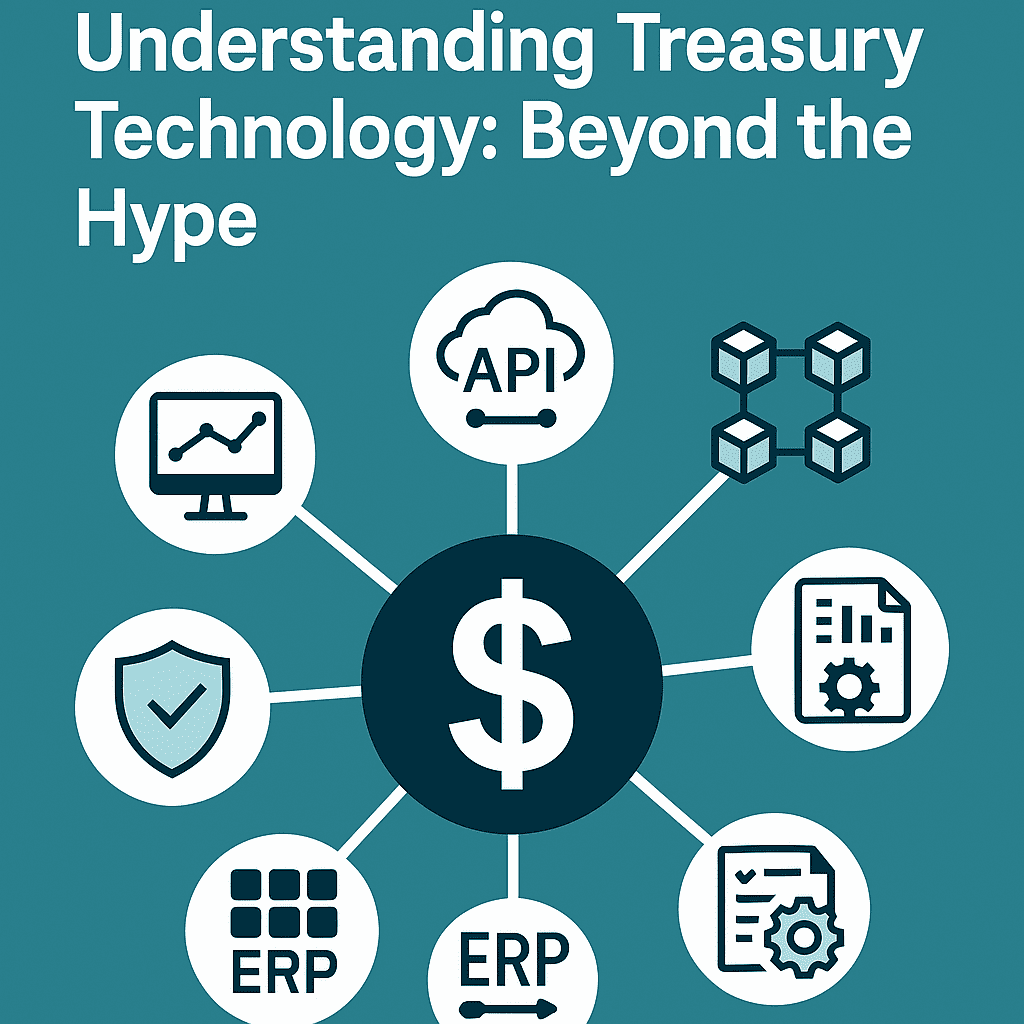Generative AI in Treasury can handle complex technical work behind the scenes while presenting a simple, conversational interface to the treasury professional. It gets all the benefits of advanced analytics and AI without needing to understand how the technology works. Creating a custom GPT for treasury work involves several key steps. Here’s a practical guide to help you build one that would be valuable for your treasury team:
1. Define Your Treasury GPT’s Purpose and Scope
First, identify the specific treasury functions you want your GPT to support:
- Cash flow forecasting assistance
- FX risk analysis and hedging strategy recommendations
- Investment portfolio analysis
- Liquidity management
- Bank relationship management
- Treasury policy creation and maintenance
- Regulatory compliance guidance
- Board and management reporting
2. Gather Specialized Treasury Knowledge
Your GPT will need specialized knowledge to be effective:
- Treasury policies and procedures from your organization
- Banking documentation and agreements
- Historical reports and analyses
- Treasury management system documentation
- Regulatory requirements relevant to your treasury operations
- Industry benchmarks and best practices
- Key financial data sources and structures
3. Create the GPT Using OpenAI’s GPT Builder
OpenAI’s platform allows you to create custom GPTs with specific knowledge and capabilities:
- Log in to your OpenAI account (might need a paid plan for this!)
- Access the GPT Builder (via “Create a GPT” or “Explore” → “Create” options):

3. Define your GPT’s name (e.g., “Treasury Advisor GPT”)
4. Configure through conversation with the builder:
- Explain it’s for treasury professionals
- Define the specific treasury tasks it should help with
- Specify the tone and depth of financial expertise needed

4. Upload Reference Materials
Upload key treasury documents to give your GPT specialized knowledge, for example:
- Treasury policy manuals
- Cash forecasting templates and historical data
- Risk management frameworks
- Banking relationship documentation
- Financial reporting templates
- Investment guidelines
5. Configure Capabilities and Limitations
Customize what your Treasury GPT can do:
- Web browsing – For accessing market data, rates, and regulatory updates
- DALL-E image generation – For creating charts and visual presentations
- Code interpreter – For financial calculations and data analysis
- Actions – Optional API connections to other systems (requires development)
6. Write Effective Instructions
Create clear instructions that define how your GPT should operate:
You are a Treasury Assistant GPT specialized in corporate treasury operations.
Purpose: Help treasury professionals with cash management, liquidity forecasting,
risk management, investment analysis, and treasury reporting.
Knowledge: You have expertise in treasury operations, banking relationships,
financial markets, FX hedging, investment strategies, and treasury regulations.
Tone: Maintain a professional financial tone appropriate for treasury professionals.
Use treasury terminology correctly and precisely.
Responses:
- Provide practical, actionable treasury advice
- Include relevant financial calculations when needed
- Consider both operational and strategic treasury considerations
- Reference treasury best practices and regulations
- Format financial data clearly in tables when appropriate
- Explain treasury concepts clearly but avoid over-simplifying
- Acknowledge limitations on company-specific advice
For forecasting questions: Request information about historical patterns,
seasonality, and business factors.
For risk management: Discuss both tactical hedging approaches and strategic considerations.
Never provide specific investment advice on individual securities, but
you can discuss treasury investment approaches, policies, and frameworks.
7. Test Your GPT with Treasury Scenarios
Before finalizing, test your GPT with typical treasury questions:
- “Help me understand the pros and cons of different cash pooling structures”
- “What factors should I consider when forecasting cash flow for our European subsidiaries?”
- “Create a draft FX hedging policy for a manufacturing company with exposure to EUR, GBP, and JPY”
- “Explain how SOFR differs from LIBOR and how this affects our loan agreements”
- “Help me prepare a treasury update for the board focusing on our liquidity position”
8. Deploy and Share with Your Treasury Team
Once satisfied with testing:
- Publish your GPT (can be private for your organization only)
- Share access with appropriate treasury team members
- Create a quick reference guide for effective prompting
- Collect feedback for ongoing improvements


9. Train Users on Effective Prompting
Help your treasury team get the most value by teaching them how to write effective prompts:
- Be specific about the treasury task or challenge
- Provide relevant context (company size, industry, regions)
- Specify the desired output format (analysis, recommendation, report draft)
- Include relevant constraints (regulatory requirements, policy limitations)
10. Continuously Improve Your Treasury GPT
Plan to regularly update your GPT with:
- New treasury policies and procedures
- Updated regulatory information
- Feedback from users on what’s working/not working
- Additional document uploads as treasury operations evolve
Essential Document Types & Prompt Examples
Most Valuable Document Types you can include
- Treasury Policy & Procedure Manuals
- Include your organization’s complete treasury policy manual
- Standard operating procedures for key treasury processes
- Authorization matrices and approval workflows
- Risk management frameworks and limits
- Cash Management Documentation
- Bank account structure diagrams
- Cash pooling agreements
- Liquidity management guidelines
- Cash forecasting templates and methodologies
- Investment Policy Statements
- Investment guidelines and constraints
- Approved investment instruments
- Credit quality requirements
- Duration/maturity limits
- Performance benchmarks
- Risk Management Documents
- FX hedging policy and procedures
- Interest rate risk management guidelines
- Counterparty risk assessment frameworks
- Commodity hedging strategies (if applicable)
- Banking Relationship Documents
- Key banking service agreements
- Fee schedules
- Credit facility term sheets
- Covenant requirements and definitions
- Financial & Treasury Reports
- Board-level treasury reports (as templates)
- Daily/weekly cash position reports
- Liquidity forecasts
- Investment portfolio summaries
- FX exposure reports
- Regulatory & Compliance Materials
- Relevant treasury regulations summaries
- IFRS/GAAP guidance on treasury activities
- Tax considerations for treasury operations
- Sanctions compliance procedures
- Treasury Systems Documentation
- TMS user guides (simplified versions)
- System integration diagrams
- Data dictionaries for key fields
- Report customization guides
Effective Treasury Prompt Examples
Cash Management Prompts
Based on our treasury policy, help me evaluate if we should implement a notional pooling structure for our European entities. Our current structure uses physical zero-balancing across 7 countries with EUR, GBP, and PLN currencies. We want to optimize interest and reduce intercompany loans.Review this cash forecast variance report and generate a summary analysis explaining the key drivers of the €2.1M variance in our German subsidiary. Focus on identifying patterns and potential process improvements.Create a decision framework for selecting new cash management banks in the APAC region. We have operations in Singapore, Australia, Japan, and Thailand with approximately $75M monthly flow. Include evaluation criteria and a scoring template.Risk Management Prompts
Based on our FX hedging policy, help me develop a hedging strategy for a new €50M exposure from our recently acquired French subsidiary. The exposure will last 18 months with quarterly cash flows. I need to consider both accounting and economic perspectives.Review these interest rate scenarios and suggest how we should structure our debt portfolio. We currently have 75% fixed/25% floating with $500M total debt. Our policy allows 60-80% fixed rate exposure.Generate a comprehensive counterparty risk assessment template for our banking relationships that incorporates CDS spreads, credit ratings, and our internal exposure limits. Our treasury policy requires quarterly review of all counterparties with exposure over $10M.Investment Management Prompts
Based on our investment policy, analyze these three investment options for our 6-month excess cash position of $25M. Consider liquidity needs, yield, and compliance with our policy constraints on credit quality (minimum A-rated) and duration (maximum 9 months).Help me create a quarterly investment portfolio review for our board. We need to show performance vs. benchmarks, compliance with investment policy, and outlook for the next quarter. Our portfolio is $150M with 80% in money market funds and 20% in short-term corporate bonds.Draft an update to our investment policy that incorporates ESG considerations while maintaining our primary objectives of capital preservation and liquidity. We need to align with our corporate sustainability goals while ensuring regulatory compliance.Reporting & Analysis Prompts
Generate a comprehensive treasurer's report for our upcoming board meeting. Focus on: 1) Liquidity position and forecasts, 2) Debt portfolio and covenant compliance, 3) FX exposures and hedging activities, and 4) Key treasury projects. Use our standard treasury reporting format.Analyze this working capital data and identify optimization opportunities across our subsidiaries. We're particularly focused on DSO reduction in our European entities where the average is currently 65 days versus our target of 45 days.Create a treasury dashboard template that effectively communicates our key metrics to the CFO. Include cash positions, debt maturity profile, investment portfolio allocation, FX exposures, and key risk indicators. Format it for a monthly review meeting.Compliance & Governance Prompts
Review this draft amendment to our credit facility and highlight key terms that may impact our treasury operations, particularly regarding cash pooling restrictions, permitted investments, and financial covenant calculations.Based on our treasury policy, create a comprehensive checklist for quarterly policy compliance certification. Include all key policy requirements across cash management, investments, risk management, and banking relationships.Develop a treasury internal control self-assessment questionnaire that covers all key control points in our treasury policy. Structure it to align with our annual SOX 404 compliance requirements.Strategic Treasury Prompts
Help me develop a treasury transformation roadmap for the next 3 years. We're a $2B manufacturing company with operations in 12 countries. Focus on technology, process optimization, and organizational structure to enhance our treasury capabilities.Create an evaluation framework for selecting a new Treasury Management System. Our priorities are cash visibility, forecasting, bank connectivity, and investment portfolio management. We have 50+ bank accounts across 8 banking partners.Develop a treasury strategy presentation that explains how treasury can support our company's international expansion into Latin America. Include considerations for banking structure, cash repatriation, FX risk management, and funding strategies.These documents and prompt examples will give your Treasury GPT a solid foundation of specialized knowledge while providing your treasury team with effective ways to interact with it.
Disclaimer
This article provides a technical framework and demonstrates how to leverage existing tools to streamline treasury processes. The implementation described here assumes:
- Appropriate governance frameworks are already in place within your organization.
- Human oversight remains essential at critical approval points as detailed in the workflow.
- Organization-specific controls must be integrated based on your company’s policies and risk tolerance.
This guide focuses exclusively on the technical implementation aspects rather than governance, compliance, or accountability frameworks, which will vary by organization/ country/ region. Always consult with your compliance, security, finance, and legal teams to ensure the solution meets your organization’s specific requirements and standards before implementation.
Any automation solution should enhance—not replace—human judgment in financial processes. I don’t suggest full automation of processes, but rather the streamlining of workflows while maintaining appropriate controls.








Leave a Comment
You must be logged in to post a comment.